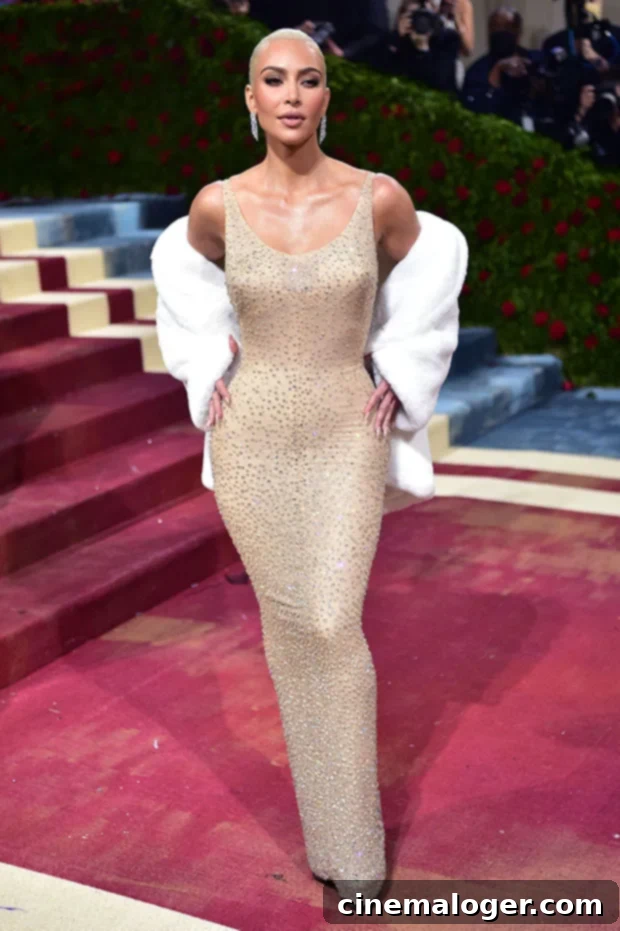Kim Kardashian’s Met Gala Moment: The Marilyn Monroe Dress Controversy and Its Lasting Impact on Fashion History
The 2022 Met Gala delivered an unforgettable moment that sparked a global conversation, extending far beyond the typical fashion critiques. Reality television star and entrepreneur Kim Kardashian made headlines by gracing the red carpet in the iconic “Happy Birthday, Mr. President” gown once worn by Hollywood legend Marilyn Monroe. This decision, intended as a tribute, quickly ignited a fierce debate among fashion enthusiasts, historians, and preservationists, thrusting the delicate balance between celebrity culture and historical artifact protection into the spotlight.
Marilyn Monroe originally wore the bespoke Jean Louis gown in 1962, serenading President John F. Kennedy on his 45th birthday. The dress, adorned with over 2,500 hand-stitched crystals, was famed for its illusionary “naked” look, custom-fitted to Monroe’s exact measurements, and designed to be so form-fitting that it had to be sewn onto her. Its appearance on Kim Kardashian sixty years later was undoubtedly one of the biggest moments of the Met Gala, captivating millions and almost immediately drawing both admiration and fervent criticism.
Bob Mackie’s Scathing Critique: “Nobody Else Should Be Seen In That Dress”
Among the most vocal critics was legendary fashion designer Bob Mackie. At 82 years old, Mackie is a titan in the industry, renowned for his elaborate and often extravagant designs, having dressed everyone from Cher to Carol Burnett. His opinion on the Met Gala dress choice carried significant weight, not only due to his status but also his direct, albeit early, connection to the gown itself. Mackie didn’t mince words when expressing his disapproval.
“I thought it was a big mistake,” Mackie unequivocally stated in an interview with Entertainment Weekly. His reasoning was rooted in a profound reverence for Monroe and the unique circumstances of the dress’s creation. “[Marilyn] was a goddess. A crazy goddess, but a goddess. She was just fabulous. Nobody photographs like that. And it was done for her. It was designed for her. Nobody else should be seen in that dress.” Mackie’s sentiment captured the feeling of many who viewed the dress as an extension of Monroe’s persona, an inseparable piece of her legacy that should remain untouched by others.
A Personal Connection to the Iconic Gown
Bob Mackie’s objection stemmed from more than just a general artistic principle; it was deeply personal. Early in his illustrious career, Mackie worked as an assistant to the celebrated French designer Jean Louis, who created Monroe’s gown. At the tender age of 23, it was Bob Mackie himself who drew the original sketch for the garment. At the time, he was unaware of the immense historical significance it would quickly attain, knowing only that it was a unique piece commissioned for Ms. Monroe.
This direct involvement granted Mackie a unique perspective on the gown. He understood its craftsmanship, its fragility, and the very essence of its conception as a garment specifically tailored to one of the most iconic figures of the 20th century. To him, the dress was not merely a piece of fabric and sequins; it was an artistic expression crafted for a specific muse, becoming intrinsically linked to her identity and a pivotal moment in American history. For this reason, seeing it worn by another, regardless of their celebrity status, felt like a misappropriation of its original intent and historical sanctity.

The Historical Significance of Marilyn’s Gown
The “Happy Birthday” dress holds a monumental place in cultural history. Marilyn Monroe’s performance for President Kennedy at Madison Square Garden on May 19, 1962, was one of her last major public appearances before her untimely death a few months later. The sensuous, breathy rendition of the song, coupled with the scandalous “naked” dress—which shimmered as if she were nude beneath a sheer layer—cemented the moment as one of the most iconic, and controversial, in celebrity history.
Jean Louis’s design was a stroke of genius, creating an illusion of daring sensuality while maintaining an air of sophisticated glamour. The gown’s construction, meticulously handcrafted and embedded with thousands of crystals, made it not just a dress but a work of art. Its rarity, its connection to a pivotal political and cultural moment, and its association with one of the most enduring symbols of Hollywood glamour have ensured its status as an unparalleled historical artifact. The dress is more than just fashion; it is a tangible piece of a bygone era, a relic of a unique intersection of celebrity, politics, and design.
The Delicate Debate: Preservation vs. Public Display
Beyond the aesthetic and emotional arguments, the controversy surrounding Kim Kardashian wearing the dress brought critical issues of historical garment preservation to the forefront. Fashion historians and archivists have long grappled with the challenges of maintaining fragile textiles and garments that are often hundreds of years old. The Met Gala incident reignited a passionate debate about the ethics of allowing priceless historical artifacts to be worn, even briefly, for public display.
Alicia Malone, a film historian who spoke with EW alongside Bob Mackie as part of TCM’s upcoming fashion on film series, Follow the Thread, articulated many of these concerns. “There are all the issues with the actual preservation of the dress, and things like oxygen can affect a dress,” Malone explained. She highlighted that these garments are typically housed in “very much in controlled environments.” Institutions like The Costume Institute at the Met are renowned for their meticulous care in handling such historic items. “So, it was quite alarming that she was able to wear it. I personally wish she wore a replica instead of the real thing.”
The Science of Garment Preservation
The concerns raised by Malone and others are rooted in the scientific principles of textile conservation. Historical garments, especially those made from delicate materials like silk, crepe, and embellished with sequins and beads, are incredibly vulnerable to degradation. Factors such as light exposure (UV and visible), humidity fluctuations, temperature changes, and even the natural oils and acids from human skin can cause irreversible damage. Oxygen itself, while essential for life, contributes to the oxidative decay of organic materials, weakening fibers and altering dyes over time.
Museums and archives go to great lengths to mitigate these risks. This often involves storing garments in darkened, climate-controlled vaults with carefully regulated temperature and relative humidity levels. They are typically handled only by gloved professionals and transported in specialized, cushioned containers. Even minimal handling or exposure to an uncontrolled environment, like a red carpet event, can cause micro-tears, stretched seams, lost embellishments, or accelerated chemical degradation that may not be immediately visible but contributes to the garment’s eventual deterioration. The value of a historical piece lies not just in its appearance but in its authenticity and integrity, which preservationists strive to maintain for future generations.

Kim Kardashian’s Approach: Respect and Replicas
In response to the mounting concerns and widespread criticism, details emerged about the stringent measures taken by Kim Kardashian and the dress’s owner, Ripley’s Believe It Or Not!, to minimize potential harm. According to Vogue, Kim did wear a replica for the majority of the Met Gala event. Her interaction with the original gown was strictly limited to the red carpet portion.
The process was meticulously planned: Kim arrived at a small, specially designated fitting room near the Met Gala venue in a dressing gown. There, she changed into the $4.8 million original dress with the assistance of a conservationist from Ripley’s. She walked the red carpet alongside her then-boyfriend Pete Davidson, posed for photographs, and crucially, once she had successfully ascended the famous Met steps, she immediately changed out of the original dress and into a precise replica. This replica was also owned by Ripley’s, ensuring a consistent visual for the remainder of the evening while safeguarding the original artifact.
Kim Kardashian herself addressed the concerns, emphasizing her deep respect for the garment and its place in American history. “I’m extremely respectful to the dress and what it means to American history,” Kim told Vogue. She further elaborated on the precautions she took: “I would never want to sit in it or eat in it or have any risk of any damage to it, and I won’t be wearing the kind of body makeup I usually do.” These statements aimed to reassure the public that the delicate balance between display and preservation was a primary consideration, even amidst the spectacle of the Met Gala.
Ripley’s Role and the Loaned Artifact
The decision to loan Marilyn Monroe’s dress to Kim Kardashian rested with Ripley’s Believe It Or Not!, which acquired the gown for a record-breaking $4.8 million at auction in 2016. As the current custodians of this invaluable piece of history, Ripley’s has a vested interest in its preservation, but also in its public display and educational potential. Their choice to allow Kardashian to wear it, albeit under strict conditions, was a calculated move that undeniably generated immense publicity for both Kardashian and the artifact itself.
Ripley’s defended their decision by stating that every precaution was taken to ensure the dress’s integrity. They emphasized the short duration of its wear, the presence of trained conservators, and the swift change into a replica. Their stance was that sharing such historical items with the public, even in unconventional ways, helps to keep their stories alive and relevant for new generations. However, this perspective directly clashed with that of many museum professionals who advocate for a ‘hands-off’ approach to irreplaceable artifacts, believing that any form of wear constitutes an unacceptable risk.
Beyond the Gown: Broader Implications for Fashion History
The Kim Kardashian/Marilyn Monroe dress incident transcends a single Met Gala moment; it has opened a wider dialogue about the future of archival fashion, celebrity influence, and the ethics of historical preservation. In an era where vintage and archival pieces are increasingly coveted by celebrities for red carpet events, the question of what constitutes an acceptable use of these fragile relics becomes paramount.
While wearing a mass-produced vintage garment is one thing, donning a unique, custom-made artifact with profound historical significance is another entirely. The controversy highlights the tension between making history accessible and maintaining its integrity. Does allowing a celebrity to wear such a piece introduce it to a new, younger audience, fostering a greater appreciation for fashion history? Or does it commodify and potentially endanger irreplaceable objects, setting a dangerous precedent for the handling of other priceless artifacts?
A Legacy Divided: The Ongoing Conversation
The debate surrounding Kim Kardashian’s Met Gala appearance in Marilyn Monroe’s iconic gown is unlikely to subside quickly. It serves as a potent reminder of the complexities inherent in preserving cultural heritage while simultaneously engaging with contemporary celebrity culture. Bob Mackie’s passionate plea for the dress to remain a singular tribute to Marilyn, coupled with the detailed concerns of preservationists like Alicia Malone, underscore the deep reverence many hold for these tangible links to the past.
Conversely, Kim Kardashian and Ripley’s demonstrated a desire to honor history through a grand gesture, believing that responsible, albeit brief, public display could enhance its relevance. Ultimately, the incident has left a lasting mark, forcing the fashion world, museums, and the public alike to critically examine our collective responsibility towards historical artifacts and ponder how best to balance their protection with their power to inspire and captivate. The “Happy Birthday, Mr. President” dress continues its storied life, now with another chapter etched into its delicate fabric, forever linking it to two of pop culture’s most defining figures.
